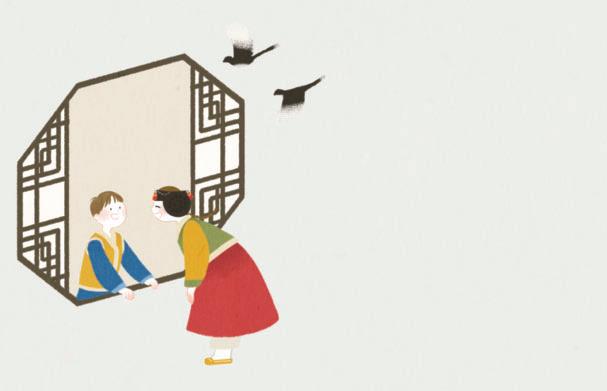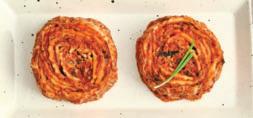
7 minute read
K-FOOD RECIPE
Dubu-Kimchi A Good Combination of Spicy Kimchi & Soothing Dubu
Dubu-kimchi(bean curd kimchi) is a dish that with stir-fried can be easily made with a handful of kimchi and a block of dubu. Anyone can make this simple yet tasty food only with a warm block of dubu with the addition of well-ripen kimchi or stirfried kimchi. The dish is very simple to make and low in calories. So, it is used as a diet food. Also, its spicy yet simple taste makes the food a good accompaniment to alcoholic drinks. Cha Eun-woo, aka “face genius”, introduces the simple recipe for dubu-kimchi that he never fails to eat every year.
Advertisement
Dubu-Kimchi Recipe
Two Servings Cooking Time: 15min 300kcal(two servings)
2 3 1
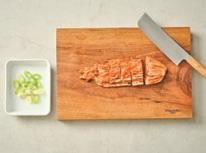

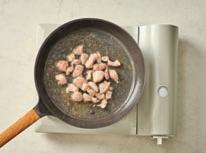

4
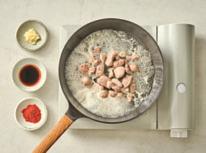
5
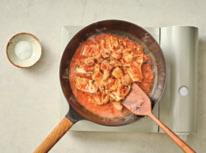
Main Ingredients dubu 300g, kimchi 180g, pork shoulder 180g, 1/2 large green onion
Sub Ingredients(sauce) 1 tbsp of red pepper powder, 0.5 tbsp of minced garlic, 1 tbsp of sugar, 2 tbsp of soy sauce, 1 tbsp of sesame oil
Tip Dubu-kimchi can be tastier when it is made with well-ripened kimchi. When kimchi does not taste sour, add a small drop of vinegar to have a similar taste to that of well-ripened kimchi.
6 7
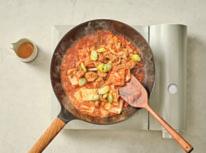
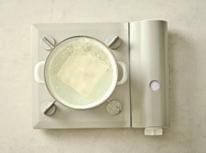
1 2
Roast the prepared meat on a frypan.
Cut large green onion and kimchi into bite-sized pieces before the pork is done.
3 4
Pour 100ml water when the blood is drawn out of the pork.
When the water boils, put one tablespoon of red pepper powder, two tablespoons of soy sauce, and half a spoon of minced garlic, and mix them well.
5
Put well-ripened kimchi and one tablespoon of sugar, and then stir-fry them.
6
Add the prepared large green onion and one tablespoon of sesame oil, and then stir-fry them altogether.
7
Cook dubu in boiling water for about five minutes and cut it into suitable-sized pieces, and then put the dubu and the kimchi on a plate.
KoreaAgrafood KoreaAgrafood
Makgeolli,
A Perfect Pair
There are dubu-kimchi in Korea, while there are fish and chips in the United Kingdom. Fish and chips have their perfect pair with beer. Dubu-kimchi have their own pair, and it is the very Korean rice wine, or makgeolli in Korean. With a little hyperbole, makgeolli cannot be ruled out when it comes to dubu-kimchi. This is highly associated with the Korean culture where people drink makgeolli to comfort fatigue right after they do some arduous work or physical activities such as farming, hiking, and such. Dubu -kimchi that is easy to make and store naturally became the perfect mate with the makgeolli. The makgeolli is made with rice, and it is also good for a spicy dish. It can neutralize further the spiciness of kimchi along with dubu. That’s why the makgeolli is all the more perfect for the dish.
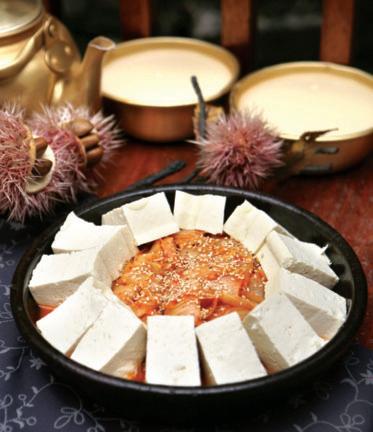
Exported Makgeolli & Dubu Products
Baehaejung Doga’s Buja Makgeolli
Baehaejung Doga produces makgeolli of premium line Buja. Buja makgeolli is excellent in fragrance and flavor of malt that is considered the life of makgeolli. It contains a great amount of amino acid and dietary fiber and comes in various types with alcohol contents 10%, 13%, and 16%. In addition to Buja makgeolli, the drink company produces other types of makgeolli made with different ingredients such as grapes, purple sweet potatoes, and corns.
+82-2-3462-7328 www.baedoga.co.kr
Girin Wondang Nonghyup’s Wondang Dubu Korean Soybean
Girin Wondang Nonghyup produces dubu with 100% Korean soybeans. It makes dubu using only first-grade soybeans that are the main ingredient for dubu. It is equipped with a cutting-edge automated facility and obtained the Hazard Analysis and Critical Control Points(HACCP) certificate. It sells various dubu products including dubu for fried food, dubu for stew, and soft dubu. Dubu for fried food can be a good choice to make dubu-kimchi.
+82-33-462-4919 kwnhtofu.nonghyup.com
Traditional Korean Holiday Seollal
Seollal, Korean New Year’s Day, is one of the biggest national holidays that celebrate the first day of a year. It is based on the lunar calendar and differs slightly each year. This year, the day falls on February 12 by the solar calendar. Koreans perform ancestral rites in the morning of the day and pay visits to their elders and relatives to give their New Year’s bows. Also, they make various dishes to do the rites and greet their visitors. Tteokguk(sliced rice cake soup) is a dish that represents this big day of the year. That is why there is a saying that, when you eat one bowl of tteokguk on that day, you become a year older after the day. On or around the first day, Koreans enjoy various traditional plays such as yut-nori(four-stick game), neolttwigi(jumping game similar to see-sawing), and kite-flying. Let’s learn about some unique Korean cultures on New Year’s Day.
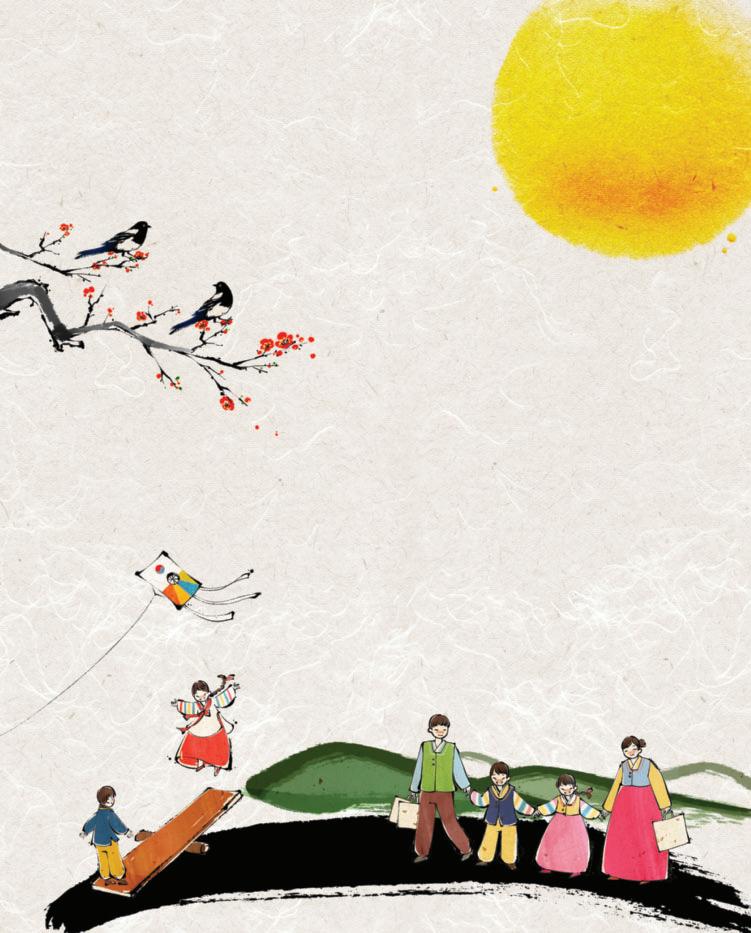
Seolbim New Year’s Dress
When a new year comes, most Koreans put on clothes after a bath, which is called ‘seolbim’. new This is to greet a new year with a pure soul before their ancestors and elders. Seolbim depends on the ages and circumstances. Traditionally, those who are well off buy a new suit of clothes. But, others who are not buy a pair of traditional Korean socks at least. Koreans dress their children in colorful and bright-colored clothes, wishing for them to grow bright and successful.
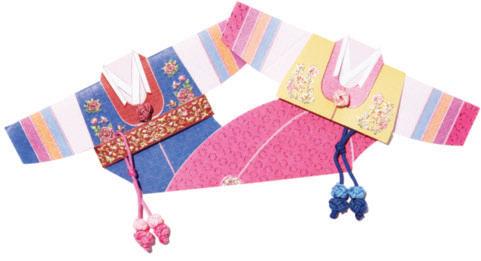
Sebae Bows for Good Health & Happiness
On the morning of the first day of a new year, Koreans perform a rite for their ancestors. They set the tables for the rites and wish for peace and happiness for their families in front of their ancestors. After the rite, they bow to their parents or elder members of their families. Some visit teachers or elders they respect to give greetings for the new year. The New Year’s bow is an act of kneeling and lowering their heads with their body bent to show their respect. The elders who receive the bows give cash gifts or words of blessing to the youngers in return.
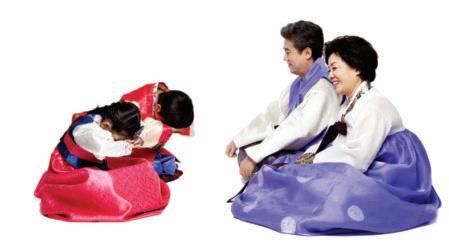
Tteokguk for Health & Financial Fortune
How to make the tables for the rites on New Year’s Day differs from family to family. However, they observe a common tradition of eating tteokguk in Korean. Eating one bowl of tteokguk means growing a year older. Stick-like long rice cake, or garaetteok in Korean, which is a main ingredient for the soup, connotes a long life without diseases and financial fortune extending like the long rice cake. During the late Goryeo Dynasty, Koreans added pheasant meat to the soup, but ordinary people at that time could not afford to buy pheasants. So, they added a chicken instead of a pheasant, from which the famous Korean saying, “a chicken instead of a pheasant”(means similarly to “if you can’t get a horse, ride a cow”), came.
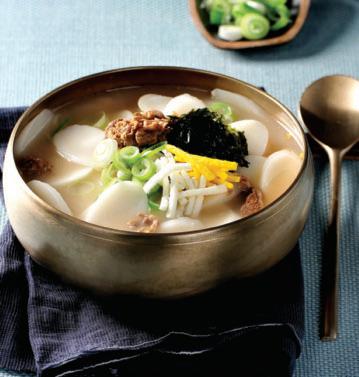
Bokjori Lucky Bag full of New Year’s Blessings
Koreans have the tradition of hanging a strainer that thin strips of bamboo high on a wall early in is made the with woven morning on New Year’s Day. A strainer is originally a kitchen utensil used to sift grits out when cooking rice and is thus used as a good luck charm to scoop up all the lucks of a year to come. It is also originated from the wish for abundant food throughout the year.
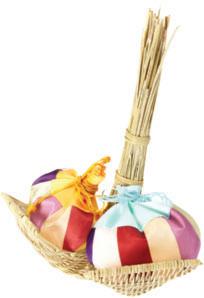
Folk Games with Special Meanings
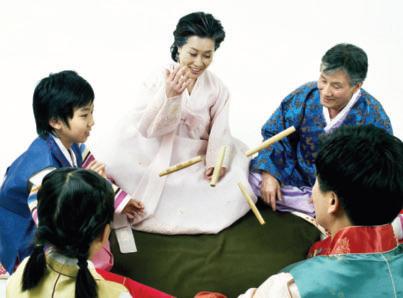
On New Year’s Day, nori, neolttwigi, and Korean ancestors did various traditional plays such as yutkite-flying to strengthen their bonds with others. Yut-nori has not its accurate origin, but is said to be played to wish for a good harvest. Neolttwigi is believed to be started from women who had lived behind a wall or fence all year round and desired to see the world outside. Kite-flying is making a kite, and flying the kite with the wind while adjusting the string connected to the kite. It is said to be played to let bad luck fly off.
Magpie’s New Year ’ s Day, One Day Before Seollal
The eve of New Year’s Day is called “Magpie’s New Year’s Day” in Korea. It is backed by an old saying that, when an(oriental) magpie cries, a welcome guest would come. Since family members, relatives, or friends who live away are all get together on New Year’s Day, they think there would be constant cries of magpies foretelling the arrival of the welcome guests on the day before the big day. There is even a children’s song entitled “Magpie Magpie New Year”, a song that comes to mind first when it comes to New Year’s Day.
